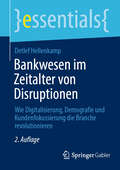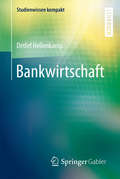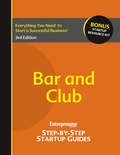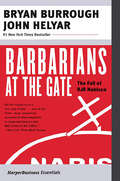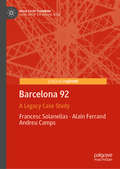- Table View
- List View
Bankwesen im Zeitalter von Disruptionen: Wie Digitalisierung, Demografie und Kundenfokussierung die Branche revolutionieren (essentials)
by Detlef HellenkampDigitalisierung, demografischer Wandel und ein sich wiederkehrend verändertes Kundenverhalten stellen das Bankwesen vor Herausforderungen, die es bisher in dieser Form noch nicht gegeben hat. Dieses essential betrachtet neben den wesentlichen Herausforderungen auch die Möglichkeiten, die diese Veränderungen mit sich bringen. Es soll dazu beitragen, sie zu verstehen und Anregungen sowie Strategien zur Anpassung im Bankwesen kritisch zu diskutieren.
Bankwirtschaft (Studienwissen kompakt)
by Detlef HellenkampDieses Buch aus der Reihe "Studienwissen kompakt" bietet einen Komplettüberblick über alle wesentlichen Teilbereiche der Bankbetriebslehre. Es unterstützt insbesondere Nebenfachstudenten bei der schnellen Erfassung des für sie relevanten Fachwissens.
Bankwirtschaft (Studienwissen kompakt)
by Detlef HellenkampDieses Buch aus der Reihe "Studienwissen kompakt" bietet einen Komplett#65533;berblick #65533;ber alle wesentlichen Teilbereiche der Bankbetriebslehre. Es unterst#65533;tzt insbesondere Nebenfachstudenten bei der schnellen Erfassung des f#65533;r sie relevanten Fachwissens.
Bankwirtschaft (Studienwissen kompakt)
by Detlef HellenkampDieses Lehrbuch gibt einen kompakten und verständlichen Überblick über alle wichtigen Institutionen, Funktionen, Rahmenbedingungen und Geschäfte der Bankwirtschaft. Darüber hinaus werden die Entstehung und die weitreichenden Auswirkungen der Finanz- und Wirtschaftskrise bis in die heutige Zeit diskutiert.Die Überarbeitung für diese Neuauflage reflektiert insbesondere die Bedeutung der Megatrends Digitalisierung (inkl. im Zahlungsverkehrsgeschäft), Nachhaltigkeit sowie Demografie für das Bankgeschäft und bringt zudem alle gesetzlichen Rahmenbedingungen auf den aktuellen Rechtsstand.Kurze Lerneinheiten, übersichtliche didaktische Module sowie die begleitende Lernkontrolle sorgen für eine nachhaltige Wissensvermittlung. Das Buch richtet sich damit an alle Leser, die sich mit Fragen der Bankwirtschaft im Rahmen ihrer Aus- und Weiterbildung (auch im Nebenfach) sowie ihrer beruflichen Praxis auseinandersetzen.
Banorte M vil: Data-Driven Mobile Growth
by Ayelet Israeli Mariana Cal Carla LarangeiraIn mid-2019, Carlos Hank, was deliberating over the results for Banorte M vil - the mobile application for Banorte, Mexico's most profitable and second-largest financial institution. Hank, who had been appointed as Banorte s Chairman of the Board in January 2015, had overseen Banorte's transformation (and multi-million-dollar investment) from a product and client volume-focused bank into a customer-centric, technology and data-driven organization with a radically new focus. Beyond investing in a new technology platform and deploying new digital channels, Banorte also invested in the development of internal capacities to convert data intelligence into profits. Spearheaded by Jos Antonio Murillo, an economist with a Ph.D. from Rice University, Banorte's Analytics Business Unit (ABU) kicked off early on 2015, reporting directly to upper management and focused on increasing customer lifetime value. Over the course of its four-year trajectory, through data analytics and experimentation, which involved both experimenting with client incentives and tailored communication strategies through multiple channels, the ABU had successfully achieved higher product placement rates, particularly under Banorte M vil's platform. Yet, with 2.25 million active users, Banorte M vil was still far from reaching its 4-million-user target by 2020. Adoption picked up, but Banorte M vil was still losing many potential adopters along the mobile customer journey, particularly in its activation phase. Furthermore, 81% of app activity was for account balance or transaction views, with financial operations, such as card or service payments or acquisition of new bank products, accounting for a minority of the activity. If Banorte wanted to remain a top player in Mexico's financial sector, it was clear to upper management that growth in mobile banking needed to be a priority.
Banorte and the Capital Call Facility: Infrastructure Finance in Mexico
by John D. Macomber Fernanda Miguel Carla LarangeiraAs a result of Mexico's pension industry deregulation, pension funds were able to invest in energy and infrastructure projects through a variety of financial instruments, particularly through Capital Development Certificates (CKDs), an asset class that served as a vehicle for investing in unlisted companies. By the end of 2017, pension funds had invested more than $16 billion in infrastructure, with CKDs as the primary investment vehicle for this sector. Motivated by increased domestic liquidity and opportunities for investment, Rodrigo Jair launched Jair Infrastructure Investments, a specialized fund with the majority of its capital raised from pension funds. Jair was approached by Felipe Duarte, head of Banorte s Infrastructure and Energy Group, who offered him a short-term credit line to increase the fund s liquidity during its investment phase. Jair had to decide whether he should deploy this line or rely exclusively on capital calls from his investors to fund his pipeline. Was it worth paying the commitment fees to achieve increased liquidity? What risks should he consider when making this decision? What are the upsides and downsides of relying on equity or debt for a fund like Jair Infrastructure Investments? Will techniques like this bring significantly more capital into infrastructure investing?
Baosteel Group: Governance with Chinese Characteristics
by Lynn Sharp Paine G. A. DonovanThe new outsider-dominated board of directors of China's state-owned Baosteel Group must decide whether to modify the Group's structure. With the completion of a pending acquisition, the Group will control four publicly listed steel-producing subsidiaries, and board members are concerned about competition among the subsidiaries and about the subsidiaries' public shareholders. Selected by the Chinese government as the first company to take part in a pilot project on corporate governance in state-owned enterprises, Baosteel and its board are under intense scrutiny by Chinese and overseas investors in the listed subsidiaries as well as by China's political leadership and the media. The case provides background on Baosteel, China's SOE reform, the Chinese government's pilot project on corporate governance, and the functioning of Baosteel's newly constituted board of directors.
Baosteel Group: Governance with Chinese Characteristics
by Lynn Sharp Paine G. A. DonovanThe new outsider-dominated board of directors of China's state-owned Baosteel Group must decide whether to modify the Group's structure. With the completion of a pending acquisition, the Group will control four publicly listed steel-producing subsidiaries, and board members are concerned about competition among the subsidiaries and about the subsidiaries' public shareholders. Selected by the Chinese government as the first company to take part in a pilot project on corporate governance in state-owned enterprises, Baosteel and its board are under intense scrutiny by Chinese and overseas investors in the listed subsidiaries as well as by China's political leadership and the media. The case provides background on Baosteel, China's SOE reform, the Chinese government's pilot project on corporate governance, and the functioning of Baosteel's newly constituted board of directors.
Bar and Club
by Entrepreneur MagazineThis kit includes:Essential industry and business-specific startup steps with worksheets, calculators, checklists and more.Entrepreneur Editors' Start Your Own Business, a guide to starting any business and surviving the first three years.Downloadable, customizable business letters, sales letters, and other sample documents.Entrepreneur's Small Business Legal Toolkit.There are few businesses as glamorous as owning a bar or club. You'll be the proprietor of the establishment where people meet, greet, eat and drink. It'll be a home away from home for some of your customers, and you'll be the ruler of this social roost.The profit potential for bars is incredible. By taking a $20 bottle of liquor, and selling it an ounce at a time for $1.50 and up, you can make as much as $192 per bottle. That's a whopping 800 percent return on your investment!Owning your own bar or club can mean long hours, meticulous attention to detail, giving up vacations and weekends, and sometimes dealing with unruly customers. But if you have a clear vision, do your homework, and learn the ins and outs of the business, it can also translate into a rewarding and financially successful enterprise. If you're friendly, outgoing, like people and have good business sense, you're already well on your way.Our step-by-step guide will help you turn your dream into a moneymaking reality. We cover the several types of bars you can open-neighborhood bar, sports bar, brewpub, wine or martini bar, and nightclub-and how to get those bar stools filled with happy customers. The author explains step by step everything you need to know before opening your doors. Topics covered include how to:*Research your target market*Find the perfect location*Hire a knowledgeable staff*Navigate the red tape that accompanies serving alcohol and food*Understand the logistics of inventory and equipping your bar*Compete with other bars and nightlife venues*Keep your clients entertained-and get them to make more purchases-once they're in your bar*And much more!We share insider tips to increase your bottom line and make your venture a success. This easy-to-use guide also includes useful sample forms, cost-cutting ideas, common mistakes to avoid, and additional resources, plus step-by-step instructions, checklists, and work sheets that will guide you through every aspect of the start-up process. Order this book today and start living your dream.
Barack Obama and the Bush Tax Cuts (A)
by Eric Werker Matthew C. WeinzierlAs his inauguration approached, President-elect Obama faced a financial sector meltdown, a costly bailout, and massive government deficits. With the economy in recession, interest rates near zero, and joblessness on the rise, Obama needed to decide whether, and how much, to use fiscal stimulus to resuscitate the economy. To help students understand Obama's options, the case reviews both the recent tax cuts under President George W. Bush, including the supply-side and demand-management justification given for them, and the broad history of fiscal policy in the United States. Instructors may also obtain a Teaching Note, written by this case's author, that provides suggestions for using this case effectively in the classroom.
Barack Obama and the Bush Tax Cuts (B)
by Matthew C. Weinzierl Jacob KuipersPresident Obama signs a major fiscal stimulus package and then must debate whether to extend the Bush tax cuts.
Barack Obama: Organizing for America 2.0
by Aaron Smith Mikolaj Jan Piskorski Laura WinigLess than a week before Barack Obama was due to be sworn in as the 44th president of the United States, Obama for America (OFA), the president-elect's official campaign organization, announced the formation of a post-election organization, Organizing for America. The new organization would keep the campaign field team offices open after Obama took charge of the country for the express purpose of influencing supporters to back his administration's agenda. The case describes the activities of the Obama for America campaign and asks whether the new president should use social media tools to activate the grassroots, or whether he should abandon these unconventional tools in order not to upset politicians in Washington.
Barbara Krakow Gallery
by Jose Luis Alvarez Nyssa LiebermannThe Barbara Krakow Gallery is a successful contemporary art gallery located in Boston. It utilizes a very rare "no haggle pricing" strategy and extended sales cycle when selling pieces to collectors. Though it remains profitable and very respected, the size and scope of the gallery will be brought into question when Barbara Krakow, its founder, retires and hands it over to her associate, Andrew Witkin.
Barbara Krakow Gallery (B): Art and the Pandemic
by David Lane Jose B. AlvarezUpdates (A) case by describing the early impact of the Covid-19 pandemic on the art market, the renaming of the gallery as the Krakow Witkin Gallery, and the response of its partners and staff to the pandemic.
Barbara Norris: Leading Change in the General Surgery Unit
by Nitin Nohria Boris Groysberg Deborah BellBarbara Norris struggles to address the many problems facing her as a recently promoted nurse manager in the General Surgery Unit (GSU) at Eastern Massachusetts University Hospital (EMU). She has inherited a unit with the lowest employee satisfaction scores and highest employee turnover rate among all of the departments at EMU. Furthermore, her new unit was infamous for its culture of confrontation, blaming and favoritism. The staff that has remained is dissatisfied, unmotivated and not functioning as a team to deliver patient care. In fact, GSU's patient satisfaction scores, although average, had been declining steadily over the past few years. Barbara has been asked by EMU'S Director of Nursing to turn the unit around in the midst of an economic crisis and deep cost-cutting measures throughout the hospital. Where and how should she begin?
Barbarians at the Gate or Turnaround Gurus? Private Equity and the Rise of the LBO
by Tom Nicholas John MaskoDuring the 1980s, leveraged buyouts (LBOs) and the private equity (PE) firms responsible for carrying them out revolutionized both investment and management in the U.S. Between 1980 and 1989, buyout activity in the U.S. surged from $1 billion per year to $60 billion. There was widespread agreement that the PE industry created enormous value, but who exactly was it creating that value for? PE firms claimed that LBOs not only benefitted investors, but also the target companies, which became leaner and more focused as PE firms turned them around. But critics argued that on balance, the PE industry left target companies foundering under mountains of debt as investors realized huge returns. In this case study, students will grapple with PE's complex legacy while learning its history. The case will trace PE's two main ingredients (the limited partnership and the LBO), examine the auspicious conditions of the 1980s that brought them together, and discuss the experiences of two very different early players in the PE field-KKR and Bain Capital.
Barbarians at the Gate: The Fall of RJR Nabisco
by Bryan Burrough John HelyarBarbarians at the Gate has been called one of the most influential business books of all time -- the definitive account of the largest takeover in Wall Street history. Bryan Burrough and John Helyar's gripping account of the frenzy that overtook Wall Street in October and November of 1988 is the story of deal makers and publicity flaks, of strategy meetings and society dinners, of boardrooms and bedrooms -- giving us not only a detailed look at how financial operations at the highest levels are conducted but also a richly textured social history of wealth at the twilight of the Reagan era. Barbarians at the Gate -- a business narrative classic -- is must reading for everyone interested in the way today's world really works.
Barbarians of Wealth
by Sara Nunnally Sandy FranksHow the actions of a few in Europe destroyed the prosperity of the many (and how it's happening again now in America)After the fall of the Roman Empire, vicious barbaric tribes including the Hunds lead by Atilla, the Mongols, Charlemagne and the Vikings invaded Europe, plundering property and destroying homes. But, they didn't just steal and destroy property in the villages; they also stole and destroyed any prosperity the villagers had previously enjoyed. What's worse is the barbarians of the Dark Ages did all of this not out of any deeply held religious or political belief, but, rather, for the oldest reason in the book - their own personal financial gain. Some things never change.Barbarians of Wealth examines how the greedy, self-serving decisions of a select group of politicians and financial institutions negatively impacts the economy and, ultimately, destroys America's prosperity and the American way of life. Compelling and engaging, the bookDetails how Goldman Sachs peddled mortgage backed securities up and down Wall Street while secretly betting against their demiseDiscusses how Sanford Weill, founder of Citigroup spent $100 million lobbying for the repeal of the Glass-Steagall Act that prevented the merger of commercial and investment banks and got his way.Examines Christopher Dodd, head of the U.S. Senate Banking Committee, has enriched himself while driving down the prosperity of his constituentsOffers up examples of other modern barbarians, including the Federal Reserve, Alan Greenspan, Hank Paulson, and Timothy Geithner.Highlights greed driven tactics of Wall Street corporations including JP Morgan, Merrill Lynch, and Salomon Brothers.Barbarians of Wealth is a timely must read for hard-working Americans concerned with their prosperity, as well as for those fascinated with the inner workings of Washington and Wall Street.
Barber of Buenos Aires: Argentina's Debt Renegotiation
by Noel Maurer Aldo MusacchioTells the story of Argentina's aggressive strategy for renegotiating its sovereign debt from 2003 to 2005. Most creditors accepted the offer to swap their debt for new securities worth 35 cents on the dollar, with no recognition of all past-due interest. Many holdouts, however, remain outside the deal. Some experts believe that Argentina's stance will have negative consequences for the country's private sector and gives a worrisome signal about public policies; others maintain that circumstances beyond the government's control had placed the country in an unsustainable situation, and the successful renegotiation opens up new opportunities. The case presents the story of Argentina's debt saga from the point of view of the country's creditors (foreign and domestic), its government, and private Argentine companies that had to do business in the post-renegotiation environment. Also, discusses the larger issue of how the international financial community should handle sovereign debt workouts.
Barbie and Ruth
by Robin GerberThe tragic and redeeming story of how one visionary woman built the biggest toy company in the world and created a global icon. Barbie and Ruth is the entwined story of two exceptional women. There's Barbie: the diminutive yet arrestingly voluptuous doll unveiled at the 1959 Toy Fair who became the treasure of 90 percent of American girls and their counterparts in 150 countries. She went on to compete as an Olympic athlete, serve as an air force pilot, work as a boutique owner, run as a presidential candidate, and ignite a cultural firestorm. And then there's Ruth Handler, Barbie's creator: the tenth child of Polish Jewish immigrants, a passionately competitive and creative business pioneer, and a mother and wife who wanted it all. After a business scandal that forced Ruth out of Mattel, the company she founded, she drew on her experience as a breast cancer survivor to start a business that changed women's lives. She was ultimately honored as a pioneer, humanitarian, and masterful entrepreneur. Based on original research, extensive interviews, and previously unavailable material, Barbie and Ruth tells the fascinating story of how two women forever changed American business and culture.
Barcelo Hotels and Resorts (A)
by John T. Gourville Marco BertiniBarcelo Hotels and Resorts must decide whether to allow its many hotels to continue to undertake separate promotional campaigns or to run, for the first time, a broad corporate-level promotion. Complicating the decision is the fact that the many hotels in its portfolio vary greatly in their character, clientele, positioning, and locations.
Barcelona 92: A Legacy Case Study (Mega Event Planning)
by Francesc Solanellas Alain Ferrand Andreu CampsBarcelona 92: A Legacy Case Study examines the effects of the organisation of Barcelona’s Olympic Games in 1992. Divided into five compelling chapters, the authors discuss issues concerning the definition of legacy, whilst also presenting new models of legacy management and measurement methods, and providing an in-depth examination of sporting, economic and social dimensions. This book offers the most significant studies and research on the 92 Olympics to date, presenting cutting-edge proposals for comparing different Olympic hosting cities into the future.
Barclays Bank and Contingent Capital Notes, 2012
by Lucy White Trent KimIn 2012, regulatory changes following the financial crisis mean that Barclays Bank is faced with the need to raise large amounts of capital in order to comply with increased capital requirements, tightening rules as to the "quality of capital," and increased risk weights for its capital markets assets. The bank is contemplating offering contingent capital bonds, which would act like debt during "normal times" but would convert to create capital should the bank hit a "triggering event." How should these instruments be designed? Can they be attractive for the bank and for investors?
Barclays Bank, 2008
by Jerome Lenhardt Lucy White Stephen Burn-MurdochIn the midst of the financial crisis, Barclays (the world's 4th largest bank by assets) is forced by UK regulators to raise more capital. Should it take up the UK government's offer to invest, or take funding from investors from the Middle East? Students may price the two deals to determine which is more expensive, and must decide whether avoiding the constraints of government ownership is worth the extra cost.
